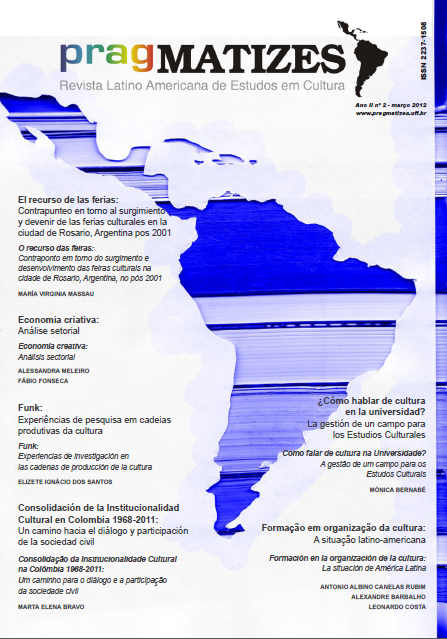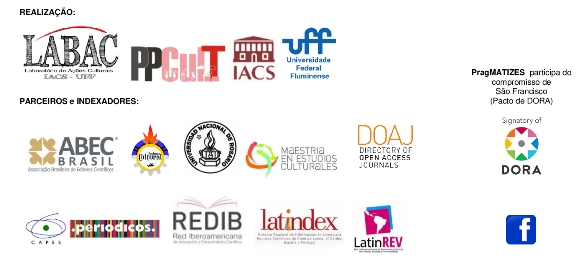Creative economy: sectorial analysis
DOI:
https://doi.org/10.22409/pragmatizes.v0i2.10343Abstract
Creative economy has been understood as a potential trigger for the
development of many nations as more than 60 countries have already
implemented systematic mapping of their creative sector. Some countries
are already in a more developed stage. The USA, Australia and
the main economies in the European community are part of this group,
mainly the UK. However, even those countries can foresee some
possibilities of growth by including the topic strategically and as a
priority in their agendas.
Emerging and developing countries can have an expressive participation
in specific areas, although there is a wide range of possibilities
remain unexploited. They should be the target of political action,
conceived and implemented with international cooperation; like the
so-called South-South Cooperation (Cooperação Sul-Sul).
Downloads
References
CASTRO, C. L.L. Debate Sobre Indústrias
Criativas: Uma Primeira Aproximação Para o
Estado da Bahia. 2005. Disponível IN:
<http://www.mesteco.ufba.br/scripts/arquivos/
at_ecobai_06.pdf>.
COMMONWEALTH. Creative Nation: Commonwealth
Cultural Policy, Canberra: 1994.
Disponível IN:
<http://www.nla.gov.au/creative.nation/contents.html>.
CHANDAVARKAR, N. Building Socially-Inclusive Creative
Economies: The Case For An International Institution. 2005.
D’ALMEIDA, F; ALLEMAN M. E. Les Industries
Culturelles Des Pays Du Sud. 2004. Disponível IN:
<http://www.francophonie.org/IMG/pdf/Industries_
cult._pays_du_sud_2004.pdf>
FIRJAN. Estudos para o Desenvolvimento do
Estado do Rio de Janeiro. A Cadeia da Indústria
Criativa no Brasil. n° 2, 2008. Disponível IN:
<http://www.firjan.org.br/data/pages/2C908CE921
B0DC40121685C72026F2E.htm>
FONSECA, A. C. R. (Org). Economia Criativa
Como Estratégia de Desenvolvimento: Uma
Visão dos Países em Desenvolvimento. São
Paulo: Itaú Cultural, 2008. Disponível IN:
<http://www.garimpodesolucoes.com.br/download
s/ebook_br.pdf>
FONSECA, A. C. R; DEHEINZELIN, L. Centro Internacional
de Economia Criativa – CIEC: Documento
Referência/Constituição Comitê Deliberativo. 2005.
FUNDAÇÃO, JOÃO PINHEIRO. Diagnóstico dos
Investimentos em Cultura No Brasil – vol. 3.1998.
GORDON, J.C. ; BEILBY-ORRIN, H. International
Measurement of the Economic and Social Importance
of Culture – (OCDE, Paris), 2007. Disponível IN:
<http://www.oecd.org/dataoecd/26/51/37257281.pdf>.
GORGULHO, L. F.; GOLDENSTEIN, M., MACHADO A. P.
V., Taboas de Mello, G. A. A Economia da Cultura, o BNDES
e o Desenvolvimento Sustentável. 2007. Disponível IN:
<http://www.bndes.gov.br/SiteBNDES/export/sit
es/default/bndes_pt/Galerias/Arquivos/conheci
mento/bnset/set3007.pdf>.
GLA Economics. London’s Creative Sector: 2004
Update. Disponível IN:
<http://www.planotecnologico.pt/document/london
_creative_sector_2004.pdf>.
HOWKINS, J. Enhancing The Creative Economy – Shaping
an International Centre on Creative Industries. Salvador: 2005.
KEA European Affairs. The Economy of culture in
Europe. 2006. Disponível IN:
<http://www.keanet.eu/ecoculture/studynew.pdf>.
MIGUEZ, P. Repertório de Fontes Sobre Economia
Criativa. 2007. Disponível IN:
<http://www.cult.ufba.br/arquivos/repertorio_econo
mia_criativa.pdf>.
MINC - Ministério da Cultura (Brasil) / IBGE –
Sistema de Informações e Indicadores Culturais.
– 2005. Disponível IN:
<http://www.ibge.gov.br/home/estatistica/popula
cao/indic_culturais/2003/indic_culturais2003.pdf>.
POL, H. van der – UIS – UNESCO. Institute for
Statistics – Measurement Issues in Relation to
Cultural Statistics. Istanbul: 2007. Disponível IN:
<http://www2.dpt.gov.tr/oecd_ing/topkapi_a/29June20
/9.00-10.30/Hendrik%20pol_-Istanbul-2007_2.ppt>.
PORTA, P. Economia da Cultura – Um Setor
Estratégico para o País. Ministério da Cultura /
PRODEC. Disponível IN:
content/uploads/2008/04/texto-sobre-o-prodec-pa
ula-porta.pdf>.
PRICEWATERHOUSECOOPERS - Global Entertainment
and Media Outlook 2006 – 2010.
PNUD. Relatório do Desenvolvimento Humano –
Liberdade Cultural num Mundo Diversificado. 2004.
Disponível IN: <http://www.pnud.org.br/rdh/>.
SÁ EARP, F. (Org). Pão e Circo: Fronteiras e Perspectivas
da Economia do Entretenimento. Rio de
Janeiro: Palavra e Imagem, 2002.
SÁ EARP, F; KORNIS, G. A Economia da Cadeia
Produtiva do Livro. Rio de Janeiro: BNDES, 2005.
UIS UNESCO Institute for Statistics - International
Flows of Selected Cultural Goods and Services,
-2003 – Defining and Capturing the Flows of
Global Cultural Trade. Montreal: 2005. Disponível IN:
<http://www.uis.unesco.org/template/pdf/cscl/Intl
Flows_EN.pdf>.
UNCTAD. Creative Economy Report – The Challenge
of Assessing the Creative Economy: Towards
Informed Policy-making. 2008. Disponível IN:
<http://www.unctad.org/en/docs/ditc20082cer_en.pdf>.
UNCTAD Secretariat, com contribuição de Jaguaribe,
A. Setting The Institutional Parameters of the
International Centre on Creative Industries (ICCI).
(documento não-oficial)
Downloads
Published
How to Cite
Issue
Section
License
By forwarding an original to PragMATIZES, the authors agree that the copyright related to it is transferred to the Publishing. Articles and other writings are made available in PDF format from their publication, and they can be downloaded to institutional repositories and personal pages, provided that with their proper bibliographic indication.



